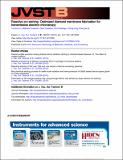| dc.contributor.author | Li, Luozhou | |
| dc.contributor.author | Trusheim, Matthew | |
| dc.contributor.author | Gaathon, Ophir | |
| dc.contributor.author | Kisslinger, Kim | |
| dc.contributor.author | Cheng, Ching-Jung | |
| dc.contributor.author | Lu, Ming | |
| dc.contributor.author | Su, Dong | |
| dc.contributor.author | Yao, Xinwen | |
| dc.contributor.author | Huang, Hsu-Cheng | |
| dc.contributor.author | Bayn, Igal | |
| dc.contributor.author | Wolcott, Abraham | |
| dc.contributor.author | Osgood, Richard M. | |
| dc.contributor.author | Englund, Dirk Robert | |
| dc.date.accessioned | 2014-04-14T16:01:53Z | |
| dc.date.available | 2014-04-14T16:01:53Z | |
| dc.date.issued | 2013-07 | |
| dc.date.submitted | 2013-05 | |
| dc.identifier.issn | 21662746 | |
| dc.identifier.issn | 2166-2754 | |
| dc.identifier.uri | http://hdl.handle.net/1721.1/86147 | |
| dc.description.abstract | Commonly used preparation method for thin diamond membranes by focused ion beam (FIB) techniques results in surface damage. Here, the authors introduce an alternative method based on reactive ion etching (RIE). To compare these methods, cross-sectional samples are produced in single crystal diamond, a material that has generated growing interest for a variety of applications. The samples are examined by Raman spectroscopy and high-resolution transmission electron microscopy (TEM). Raman spectra indicate that the crystalline structure of the RIE-processed diamond is preserved, while the FIB-processed diamond membrane has a broad-background sp[superscript 2] feature. Atomic-resolution TEM imaging demonstrates that the RIE-based process produces no detectable damage, while the FIB-processed sample has an amorphous carbon layer of about 11 nm thick. These findings show that the RIE-based process allows the production of diamond TEM samples with reduced near-surface damage and can thus enable direct examination of growth defects and crystallographic damage induced by processes such as ion implantation and bombardment. | en_US |
| dc.description.sponsorship | United States. Air Force Office of Scientific Research. Multidisciplinary University Research Initiative (Quantum Memories) | en_US |
| dc.description.sponsorship | Presidential Early Career Award for Scientists and Engineers | en_US |
| dc.description.sponsorship | United States. Air Force Office of Scientific Research. Young Investigator Program (Grant FA9550-11-1-0014) | en_US |
| dc.language.iso | en_US | |
| dc.publisher | American Vacuum Society (AVS) | en_US |
| dc.relation.isversionof | http://dx.doi.org/10.1116/1.4813559 | en_US |
| dc.rights | Article is made available in accordance with the publisher's policy and may be subject to US copyright law. Please refer to the publisher's site for terms of use. | en_US |
| dc.source | MIT web domain | en_US |
| dc.title | Reactive ion etching: Optimized diamond membrane fabrication for transmission electron microscopy | en_US |
| dc.type | Article | en_US |
| dc.identifier.citation | Li, Luozhou, Matthew Trusheim, Ophir Gaathon, Kim Kisslinger, Ching-Jung Cheng, Ming Lu, Dong Su, et al. “Reactive Ion Etching: Optimized Diamond Membrane Fabrication for Transmission Electron Microscopy.” J. Vac. Sci. Technol. B 31, no. 6 (2013): 06FF01. © 2013 American Vacuum Society | en_US |
| dc.contributor.department | Massachusetts Institute of Technology. Department of Electrical Engineering and Computer Science | en_US |
| dc.contributor.mitauthor | Bayn, Igal | en_US |
| dc.contributor.mitauthor | Englund, Dirk Robert | en_US |
| dc.relation.journal | Journal of Vacuum Science & Technology B: Microelectronics and Nanometer Structures | en_US |
| dc.eprint.version | Final published version | en_US |
| dc.type.uri | http://purl.org/eprint/type/JournalArticle | en_US |
| eprint.status | http://purl.org/eprint/status/PeerReviewed | en_US |
| dspace.orderedauthors | Li, Luozhou; Trusheim, Matthew; Gaathon, Ophir; Kisslinger, Kim; Cheng, Ching-Jung; Lu, Ming; Su, Dong; Yao, Xinwen; Huang, Hsu-Cheng; Bayn, Igal; Wolcott, Abraham; Osgood, Richard M.; Englund, Dirk | en_US |
| mit.license | PUBLISHER_POLICY | en_US |
| mit.metadata.status | Complete | |
